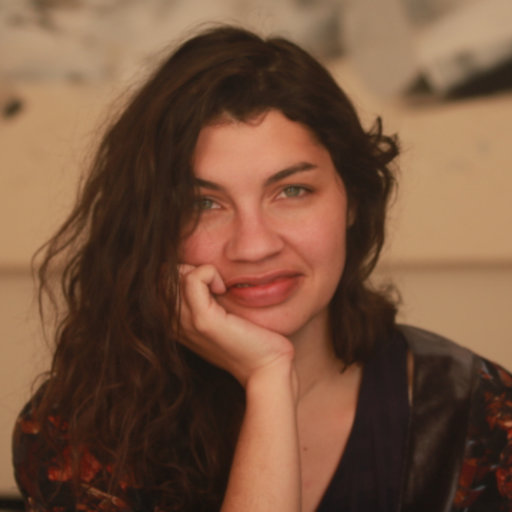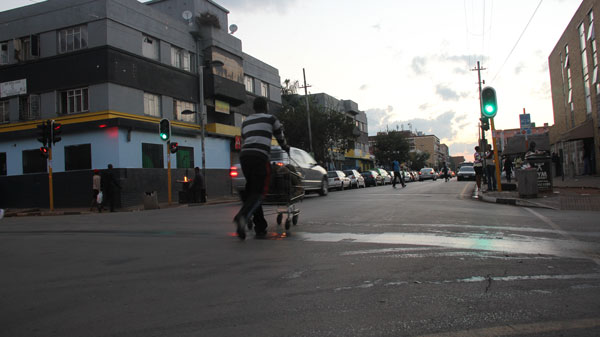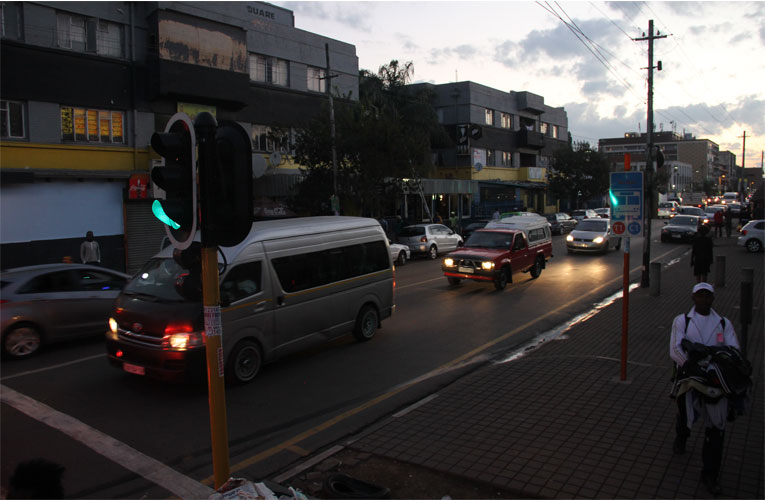Yeoville After Dark: A Place of Many Places
By Beth Vale

Nightclub cultures can illuminate the social fabric of our cities. Many of our most urgent aspirations and insecurities are laid bare on urban dancefloors. Over the past few decades, Yeoville’s life after dark has undergone tremendous shifts, mirroring dramatic socio-political changes both in Johannesburg and South Africa at large.
Popular recollections of how Yeoville emerged and changed reveal significant ‘discomforts’ in the experience of democratic transition. White liberals who believed Yeoville would be at the centre of the ‘Rainbow Nation’ were confronted by an influx of African migrants, which saw the demographics of their cosmopolitan, middle-class neighbourhood significantly changed. Meanwhile, many migrants were not welcomed by our newly-freed nation in the ways that they had hoped. A closer look into Yeoville’s nocturnal life can tell us much about the trepidations and possibilities of a city in flux.
Yeoville was built as a suburb for the upper middle-classes, to support their desires to escape the dirt of the mines. But the wealthy never took root in the suburb. Instead, it became a working-class neighbourhood with a large Jewish community, with many Eastern European Jewish immigrants. Soon, Portuguese, Italians and others joined the fold. With a predominantly white demographic, and excellent proximity to the CBD, Yeoville was zoned as a white area under the Group Areas Act.
In the late 1970s, Yeoville’s social scene started to change as clubs and galleries opened up on Rockey and Raleigh streets. The suburb developed a reputation, both locally and abroad, as South Africa’s destination night-spot, an artistic hub and an activist’s meeting place. Locals who lived there during the 80s remember a host of bars, speakeasies and music venues. “It was like your Maboneng, or your Melville, is now”, one told me. “All the trendies.” This was the time of Rockerfellas, Dylan’s, Elaine’s and Rumours Jazz Club, which once hosted American blues pianist, William ‘Champion Jack’, Dupree.

But the bustling nightlife also meant an escalation in rent prices, with many local shops driven out of business to be converted into cafés or entertainment venues. Meanwhile, Yeoville was becoming an apartheid ‘grey zone’, as different race groups came together to dance and socialise. Increasingly, white lessees started to sublet to black residents.
Meanwhile in England, the rave scene was taking off, drawing new electronic sounds from the Balearic Islands, Detroit and New York. This was twisted disco, tweaked with new technology, to produce the first wave of techno. Rave exploded through warehouses in the UK. With South Africa under sanctions, access to music from abroad had been limited. So when groups of travelling, white South Africans returned from overseas with a collection of new sounds, there was a groundswell of excitement.
In 1992, one of these Brit-influenced travellers hosted Johannesburg’s first rave at the derelict Piccadilly Bioscope, on Yeoville’s Rockey Street. The venue already had a cultural history, having been the short-lived site of Hugh Masekela’s jazz club. For the 90’s ravers, tickets were sold in little plastic bags, alongside chewing gum, condoms and a range of colourful souvenirs. Graham Hector, otherwise known as G-Force, powered the decks. Today, we know him as one of the pioneers of Newtown’s ToyToy, a Friday night residency that remains a landmark on the techno scene.
Immersed in a tense transition of power, the South African police were not too concerned with ravers. Mandela had been released, Chris Hani had been murdered, and a war was underway in Kwa-Zulu Natal. The small, white, underground rave scene was left on its own. In the UK, however, the 1995 Criminal Justice Bill would see raves outlawed, and ultimately bring a cohort of British ravers into Johannesburg. The arrival of the Brits pushed Johannesburg rave into an increasingly commercial zone. With the new arrivals driving the rave scene, parties swelled both in size and sponsorship. And so, an African-American genre from Detroit was brought to Johannesburg through a series of age-old colonial links between Britain and white South Africa.
Meanwhile, rave also became an outlet for the city’s queer culture, as white gay men in particular claimed rave as an articulation of free, uninhibited expression. Again, cultural references were drawn from elsewhere: developments in queer culture can probably be traced back to disco parties at The Loft in Manhattan. Alongside a transplanted rave culture — of ecstacy, rainbows and glowsticks — nineties Yeoville also played host to a Mardis Gras street party, plucked straight from New Orleans.
There is a heavy nostalgia that circulates among the white liberals that lived in Yeoville in the 80s and 90s. It is nostalgia for their youth, for a community that made them feel important, for unthreatening cosmopolitanism.
The parties were a series of recreated imaginings — a British warehouse, a New Orleans festival, a hopeful ‘Rainbowism’. Yeoville at night became, and remains, a place of many places. It’s a nostalgia that likely downplays many of the spatial and social injustices of Yeoville of that time. But it is also a nostalgia that attaches to a time and place when a life of experiment, play, creativity and peaceful ‘non-racialism’ seemed possible.
But the transition to democracy brought much unexpected change to Yeoville. An influx of black South Africans, and even more African migrants, moved into the suburb, having been granted new access to the city. White residents fled, partly in response to their now unfamiliar neighbourhoods, and partly in pursuit of newly-emerging hot-spots in Melville and the Northern suburbs. Banks started red-lining the area, making it nearly impossible to buy or sell property, resulting in plummeting property prices.
Many businesses and individual owners, unable to sell their properties, simply abandoned them. Former residents described a wave of crime, drugs and general decay. Meanwhile, a supposed haven of open-mindedness was infiltrated by a language of fear, alienation and sometimes prejudice. Yeoville was increasingly described as ‘overrun’, ‘going down the toilet’, at times accompanied by racist or Afrophobic rhetoric, and even apartheid nostalgia.
‘Up until the change of government, it was the coolest place you could be’, one resident said. ‘We’d all thought we were going to be in the forefront of the new South Africa. And we were the ones who lost out the most.’
And as for the party scene? By the end of the 1990’s, big alcohol brands were no longer interested in sponsoring the blowouts of a tiny white minority. Instead, they turned their attention to the emerging black market. Stephane Cohen, a French immigrant and seller of street perfumes, would go on to become one of the biggest figures in Joburg’s black club scene. One of Yeoville’s biggest 1980s DJs told me that the old Yeoville crowd still gathers in far-off places — Modderforntein or Fourways — to relive the soundtracks of their former glory in the CBD.
According to the 2011 census, 53% of Yeoville’s population is now made up of foreign nationals, although the real figure is likely to be higher. Tens of thousands of people from across the content are seeking belonging, attachment and home in this city suburb.
Those who live and party in Yeoville today still say it’s tough. It’s infrastructure is neglected, and crime and violence are palpable concerns. Nevertheless, it is now the heart of pan-Afrikanism in the city, with residents hailing from Cameroon, Ghana, Zimbabwe, Nigeria, The DRC, Ivory Coast, Mali, Ethiopia and more. It’s dancefloors are polyphonic and translingual. On Rockey Street, revellers and neon lights spill out onto the pavement in all the continent’s technicolour. The buildings still reverberate bass and laughter.
Yeoville partygoers can be found in Club 28 , Vibes or Palace Nightclub. Then there’s the club whose walls have been a witness to Yeoville’s upheaval, from the 80s to the present: House of Tandoor. Reggae and dancehall pour from the balcony, tinted in red, green and yellow. Above the entrance to Tandoor, a tribute to Great African Leaders: Patrice Lumumba, Chris Hani, Julius Nyerere, Elijah Muhammed and Walter Sisulu.Bob Marley’s 1980 performance in Zimbabwe had threaded reggae with an anti-colonial, pan-Afrikanist movement.
Today, the genre is deeply embedded in the continent’s musical identity, along with its sibling genres dub, ska and dancehall. Moving through Johannesburg’s reggae venues, one could trace the city’s Afropolitan cartography with Yeoville at its centre. The crowd sway and skank before a DJ booth, decorated in wall art. On Fridays, Japanese DJ Jun, plays the best of global reggae. Yeoville remains a contradictory place of many places, of immigrants, of night-time place-making. It’s dancefloors continue to be a volatile experiment: in who the city belongs to, where it’s been, and what it could be. Article Credit –This article was first published in Platform.










